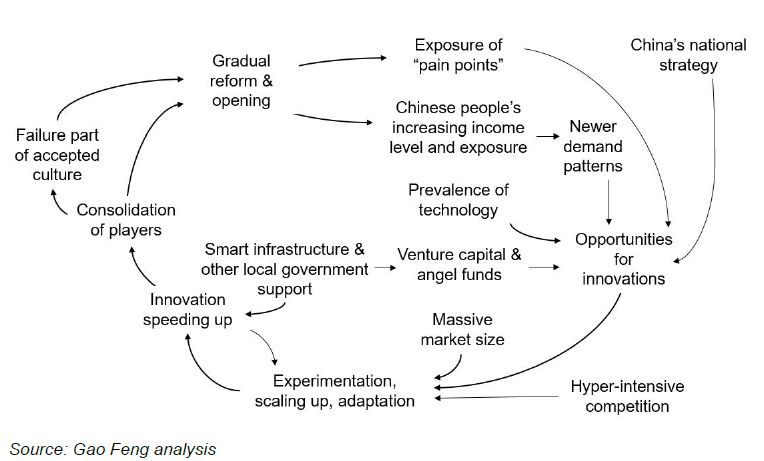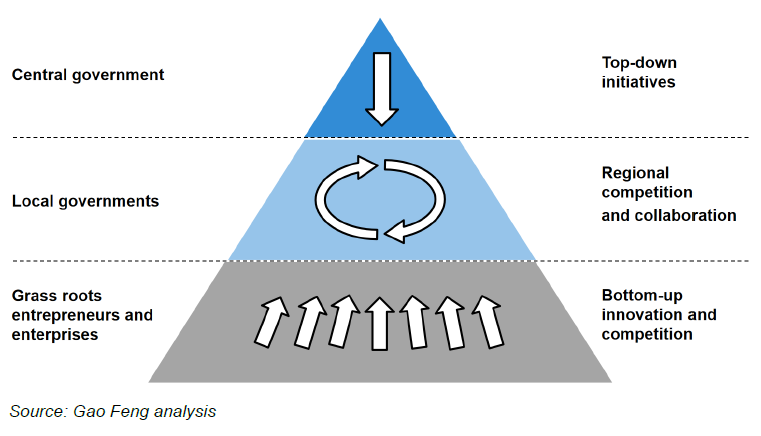【GF Viewpoint】China's Context Fostering Tech-Enabled Innovations
By Edward Tse
October 2019
A latest Gao Feng Advisory Viewpoint on China's innovations was released. In this article, Gao Feng’s CEO Dr. Tse summarized the reasons why China's innovation has come about. He believes that China's “three-layered duality” development model is the key to China’s innovations and is a source of the country's resilience.
Most observers agree that today's China is innovative. However, views differ on how “innovative” China really is and how sustainable the phenomenon can be. Tearing off the “copycat” label, China has developed a thriving internet and technology sector which has grown twice as fast as the overall gross domestic product over the past decade. According to the Hurun Global Unicorn List 2019¹, China now leads the world with the largest number of unicorns (unlisted companies valued at least 1 billion US dollars) at 206, followed by the US at 203 and India at 21.
China has demonstrated its ability to innovate, notwithstanding the contrarian beliefs of many pundits who for a long time, have insisted that lack of political freedom, a state-controlled command economy, rote learning education and inadequate intellectual property protection constitute the reasons why China cannot be innovative. Some people have even cited the small number of Nobel laureates from China in natural sciences as proof of the innate inability of the Chinese to innovate.
While none of these factors is necessarily or entirely wrong on a standalone basis, in totality, China's economic-political system presents a different case. Several drivers contribute to the rapidly growing culture of innovation in China. First and foremost is the “why not me” mindset. During the early days of reforms and opening up, many Chinese entrepreneurs witnessed a huge gap in economic conditions between themselves and accomplished achievers outside of China. This compelled them to work hard and show the world that they too could succeed. As successful Chinese entrepreneurs began to emerge over time, they became role models for other Chinese, especially younger entrepreneurs, who aspire to replicate these role models' success.
Unlike the “shock therapy” approach that Russia adopted right after the fall of the former Soviet Union, China's reform and opening has been gradual. While it has brought many challenges, it has allowed for opportunities to innovate. Each time a new reform measure is exercised, it exposes “pain points” that have existed for a long time. In turn, these pain points offer entrepreneurs the opportunity to create new solutions with the help of technology. China's expanding market size and the digital-savviness of its people also enable the entrepreneurs to rapidly scale up, learn from the market and adapt. Competition meanwhile can be extremely intense, driving entrepreneurs to constantly be on their feet, seeking the next rounds of innovations. As more experiments are taking place and as the probability of achieving success in innovation is low, failures become pretty common, and as a whole, failure is now culturally accepted in China. Many successful entrepreneurs today didn't succeed the first time and in fact have been serial entrepreneurs. Finally, and not least, venture capital and angel investors' funds are abundant and available, helping to support the entrepreneurs at different stages of their developments (see Exhibit 1).
Exhibit 1
China's Innovation Flywheel

These entrepreneurs have also inspired government officials to formulate policies to encourage entrepreneurship. In 2014, Chinese Premier Li Keqiang officially proposed “mass entrepreneurship and innovation” as a national priority, based on the achievements of Chinese entrepreneurs in innovation. That, in turn, stimulated more interest from more people to become entrepreneurs and to pursue innovative endeavors.
Does China Have a System Advantage in Innovations?
Along with the reasons above, China's “three-layered duality” development model is the key to the country's resilience in its transformation (see Exhibit 2). At the top, the central government has set the country's overarching strategy – developing into a technologically advanced and innovative society. At the grass-roots level, private sector entrepreneurs have re-emerged (since the end of the Cultural Revolution) and become a major force driving the country's economic growth. And in the middle, China's local governments channel their resources to push national and local priorities, often in close collaboration with entrepreneurs. Leading local governments provide funding to start-ups, as well as incubation infrastructure to support their ventures. While local governments often compete with each other to optimize utility of innovation to people living in their jurisdictions, some also cooperate within regional clusters, such as the “Greater Bay Area” consisting of nine cities in Guangdong Province, including Shenzhen and Guangzhou, together with Hong Kong and Macao.
The dual structure of enterprise ownership in China, comprising state-owned enterprises (SOEs) and privately-owned enterprises (POEs), is a definitive feature of its economy. While there were – and are – glitches between these two types of enterprises, they have also developed a symbiotic relationship. SOEs take on initiatives related to the country's mission-critical projects, such as the high-speed railway, which was built from virtually nothing to the world's most extensive system over slightly more than a decade. Meanwhile, POEs, led by China's entrepreneurs, have become the main drivers of market-driven innovations, often enabled by technologies such as the wireless internet. According to the data provided by the Evergrande Research Institute², Chinese POEs have achieved an admirable feat described as “456789” (using around 40% of the country's bank loans, contributing more than 50% of tax revenue, producing more than 60% of GDP, accounting for more than 70% of industrial upgrades and innovation, providing more than 80% of urban employment and owning more than 90% of enterprises).
Exhibit 2
China's Three-Layered Development Model

Let's take a look at China's automotive industry as an example. Technology is making autonomous driving an increasingly commercial reality, initially in goods movement and over time, in people movement. Private sector companies have shown that “mobility-as-a-service” (MaaS) is a large, game-changing business in China's shared economy. To catch this trend, companies – whether traditional OEMs or new disruptors, locals or foreign, state-owned or private – are all trying to position themselves as “automobility” players. They often do so through new forms of partnerships or alliances, competing or collaborating.
Toyota is one example of a company that has recognized the importance of China in the automotive industry and the need to develop a separate China specific strategy in order to meet China's unique communications, information technology and software requirements. This September, Toyota invested 600 million US dollars in DiDi, China's leading MaaS company. Along the way, the two have formed a joint venture through Toyota's local joint venture (with Guangzhou Automotive Corporation) with a plan to provide futuristic vehicle-related services to drivers on DiDi's network. These partnerships have been formed alongside similar moves targeting the US-led markets, where Toyota has been a major driver in the forming of Monet (a MaaS joint venture between Toyota, other Japanese carmakers and tech investment firm, Softbank) and making multiple investments in Uber, the leading MaaS player in the US.
Meanwhile, the Chinese central government has made smart cities construction a national strategic imperative. More extensive, intelligent and connected smart infrastructure will enable more effective and speedier development of “automobility” including smart and connected vehicles, MaaS and ultimately, autonomous driving. Both SOEs and POEs are active stakeholders and play a role in this initiative. Among others, key examples include Hangzhou's “Smart City Brain” project and pilot zones in Shanghai, Chongqing, Wuxi and other cities for autonomous driving. These developments are fundamentally disrupting the automotive industry.
Another example would be the artificial intelligence (AI) industry. Here too, collaboration between governments and businesses is just as significant. Last December, China's Ministry of Industry and Information Technology released a three-year action plan that called for breakthroughs in landmark AI products, focusing on “core competencies” such as intelligent sensors and neural network chips. Following the lead of the central government, Baidu, Alibaba, Tencent, iFlytek and SenseTime have formed the “national AI squad” for backing the development of autonomous vehicles, cloud-empowered smart cities, medical imaging, voice recognition and intelligent vision.
The US may be ahead in core research and development at least for now. However, China is catching up as the Chinese are faster in materializing commercial applications. Robin Li, the founder of Baidu, once said “the penetration of AI technology is constantly growing, at the same time the AI capability is exploding. No company can claim to be independent of AI”, stating that AI commercialization has moved towards a booming stage. Besides Internet giants, there are many entrepreneurial technology companies participating in the competition. For instance, companies like SenseTime, Megvii and Horizon Robotics are all leading AI companies with stunningly high valuations.
As China evolves fast into a leader in innovation with new disruptive technologies, businesses and in particular, the thriving tech entrepreneurs working in concert with governments both local and central, will take China through new paths onto new platforms. As a result, the industry structure, competitive conduct and financial performance of all sectors in China will evolve in their own ways into completely new forms.
What Could the Outlook Be?
One could always nitpick and say because of the lack of even one given component of this overall change, China might not be at the cutting edge of the world. However, China's edge lies in its overall approach through its system characteristics. This is being manifested through the country's three-layered duality approach in the world's largest and digitally-savvy consumer population.
As China continues the opening up and reform process, and its market continues to grow, innovation will become even more prevalent. Of course, the pathway will inevitably involve many ups-and-downs. The US-China relationship, for example, does cast a huge shadow over China's march down the path of innovation. No one should underestimate the risks involved. China won't do everything perfectly well and the China development model, which is experiential-based, will undergo more stress tests going forward. However, the intrinsic nature of China's system and the scale and diversity of its economy provide a source of resilience that is not to be discounted.
Against the backdrop of a large domestic market, entrepreneurs can launch and improve their business innovations based upon trials and market feedback. Young, daring, diverse and often epitomized by their speed and agility, the Chinese entrepreneurs are not afraid of using the market as a test-bed for new ideas. Success in entrepreneurial pursuits is a low-probability endeavor. Only a small percentage of people who try end up being successful. But with a large number of people trying, a small percentage of a large number can have a large impact.
China has evolved itself into a rather unique situation – innovation and entrepreneurship have become an integral part of the Chinese culture. This won't be going away any time soon.
References:
1. Hurun Research Institute (2019, October 21). Hurun Global Unicorn List 2019. Hurun.net. Retrieved October 21, 2019. https://www.hurun.net/EN/Article/Details?num=A38B8285034B
2. Evergrande Research Institute (2019, August 21). Current Living Environment and Suggestions for Private Enterprises. Baijiahao.baidu.com. Retrieved August 21, 2019. http://baijiahao.baidu.com/s?id=1642445902558451559&wfr=spider&for=pc

About the author
Dr. Edward Tse
CEO of Gao Feng Advisory
Dr. Edward Tse is founder and CEO of Gao Feng Advisory Company, and a founding Governor of Hong Kong Institution for International Finance. One of the pioneers in China’s management consulting industry, he built and ran the Greater China operations of two leading international management consulting firms for a period of 20 years. He has consulted to hundreds of companies, investors, start-ups, and public-sector organizations (both headquartered in and outside of China) on all critical aspects of business in China and China for the world. He also consulted to the Chinese government on strategies, state-owned enterprise reform and Chinese companies going overseas, as well as to the World Bank and the Asian Development Bank. He is the author of several hundred articles and four books including both award-winning The China Strategy (2010) and China’s Disruptors
You may visit Dr. Tse's blog to explore more of his intellectual capital: www.edwardtseblog.com
Share this:
Previous:Gao Feng Viewpoint | The Greater...
Next:None

